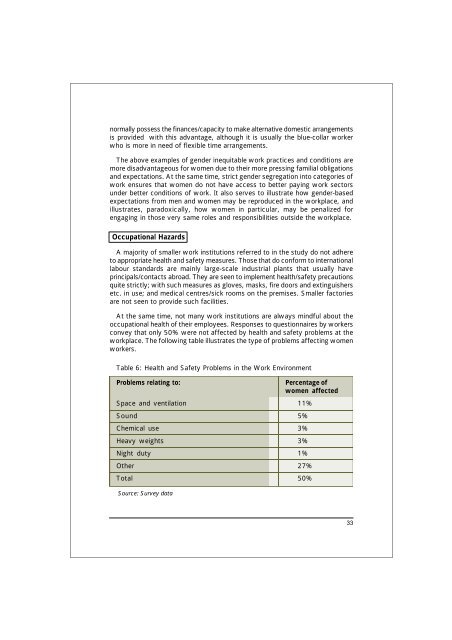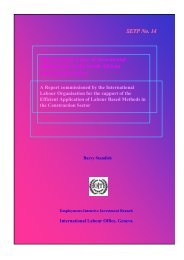Beyond Glass Ceilings and Brick Walls - International Labour ...
Beyond Glass Ceilings and Brick Walls - International Labour ...
Beyond Glass Ceilings and Brick Walls - International Labour ...
Create successful ePaper yourself
Turn your PDF publications into a flip-book with our unique Google optimized e-Paper software.
normally possess the finances/capacity to make alternative domestic arrangements<br />
is provided with this advantage, although it is usually the blue-collar worker<br />
who is more in need of flexible time arrangements.<br />
The above examples of gender inequitable work practices <strong>and</strong> conditions are<br />
more disadvantageous for women due to their more pressing familial obligations<br />
<strong>and</strong> expectations. At the same time, strict gender segregation into categories of<br />
work ensures that women do not have access to better paying work sectors<br />
under better conditions of work. It also serves to illustrate how gender-based<br />
expectations from men <strong>and</strong> women may be reproduced in the workplace, <strong>and</strong><br />
illustrates, paradoxically, how women in particular, may be penalized for<br />
engaging in those very same roles <strong>and</strong> responsibilities outside the workplace.<br />
Occupational Hazards<br />
A majority of smaller work institutions referred to in the study do not adhere<br />
to appropriate health <strong>and</strong> safety measures. Those that do conform to international<br />
labour st<strong>and</strong>ards are mainly large-scale industrial plants that usually have<br />
principals/contacts abroad. They are seen to implement health/safety precautions<br />
quite strictly; with such measures as gloves, masks, fire doors <strong>and</strong> extinguishers<br />
etc. in use; <strong>and</strong> medical centres/sick rooms on the premises. Smaller factories<br />
are not seen to provide such facilities.<br />
At the same time, not many work institutions are always mindful about the<br />
occupational health of their employees. Responses to questionnaires by workers<br />
convey that only 50% were not affected by health <strong>and</strong> safety problems at the<br />
workplace. The following table illustrates the type of problems affecting women<br />
workers.<br />
Table 6: Health <strong>and</strong> Safety Problems in the Work Environment<br />
Problems relating to:<br />
Percentage of<br />
women affected<br />
Space <strong>and</strong> ventilation 11%<br />
Sound 5%<br />
Chemical use 3%<br />
Heavy weights 3%<br />
Night duty 1%<br />
Other 27%<br />
Total 50%<br />
Source: Survey data<br />
33
















